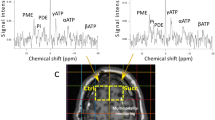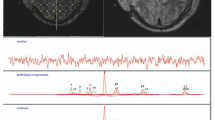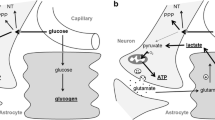Abstract
Impaired cerebral energy metabolism may be a major contributor to the secondary injury cascade that occurs following traumatic brain injury (TBI). To estimate the cortical energy metabolic state following mild and severe controlled cortical contusion (CCC) TBI in rats, ipsi-and contralateral cortical tissues were frozen in situ at 15 and 40 min post-injury and adenylate (ATP, ADP, AMP) levels were analyzed using high-performance liquid chromatography (HPLC) and the energy charge (EC) was calculated. At 15 min post-injury, mildly brain-injured animals showed a 43% decrease in cortical ATP levels and a 2.4-fold increase in AMP levels (P < 0.05), and there was a significant reduction of the ipsilateral cortical EC when compared to sham-injured animals (P < 0.05). At 40 min post-injury, the ipsilateral adenylate levels and EC had recovered to the values observed in the sham-injury group. In the severe CCC group, there was a 51% decrease in ipsilateral cortical ATP levels and a 5.3-fold increase in AMP levels with a significant reduction of cortical EC at 15 min post-injury (P < 0.05). At 40 min post-injury, a 2.6-fold ipsilateral increase in AMP levels and an 11% and 44% decrease in EC and ATP levels, respectively, remained (P < 0.05). A 37–38% reduction of the total adenylate pool was observed ipsilaterally in both CCC severity groups at the early time-point, and a 19% and 28% decrease remained in the mild and severe CCC groups, respectively, at 40 min post-injury. Significant contralateral ATP and EC changes were only observed in the severe CCC group at 40 min post-injury (P < 0.05). The energy-requiring secondary injury cascades that occur early post-injury do not challenge the brain tissue to the extent of ATP depletion and may provide a window of opportunity for therapeutic intervention.


Similar content being viewed by others
References
McIntosh TK, Saatman KE, Raghupathi R, Graham DI, Smith DH, Lee VM, Trojanowski JQ (1998) The Dorothy Russell Memorial Lecture. The molecular and cellular sequelae of experimental traumatic brain injury: pathogenetic mechanisms. Neuropathol Appl Neurobiol 24:251–267
Chen S, Pickard JD, Harris NG (2003) Time course of cellular pathology after controlled cortical impact injury. Exp Neurol 182:87–102
McIntosh TK, Juhler M, Wieloch T (1998) Novel pharmacologic strategies in the treatment of experimental traumatic brain injury: 1998. J Neurotrauma 15:731–769
Marklund N, Bakshi A, Castelbuono DJ, Conte V, McIntosh TK (2006) Evaluation of pharmacological treatment strategies in traumatic brain injury. Current Pharmaceutical Design 12(13):1645–1680
Narayan RK, Michel ME, Ansell B, Baethmann A, Biegon A, Bracken MB, Bullock MR, Choi SC, Clifton GL, Contant CF, Coplin WM, Dietrich WD, Ghajar J, Grady SM, Grossman RG, Hall ED, Heetderks W, Hovda DA, Jallo J, Katz RL, Knoller N, Kochanek PM, Maas AI, Majde J, Marion DW, Marmarou A, Marshall LF, McIntosh TK, Miller E, Mohberg N, Muizelaar JP, Pitts LH, Quinn P, Riesenfeld G, Robertson CS, Strauss KI, Teasdale G, Temkin N, Tuma R, Wade C, Walker MD, Weinrich M, Whyte J, Wilberger J, Young AB, Yurkewicz L (2002) Clinical trials in head injury. J Neurotrauma 19:503–557
Katayama Y, Becker DP, Tamura T, Hovda DA (1990) Massive increases in extracellular potassium and the indiscriminate release of glutamate following concussive brain injury. J Neurosurg 73:889–900
Nilsson P, Hillered L, Olsson Y, Sheardown MJ, Hansen AJ (1993) Regional changes in interstitial K+ and Ca2+ levels following cortical compression contusion trauma in rats. J Cereb Blood Flow Metab 13:183–192
Osteen CL, Moore AH, Prins ML, Hovda DA (2001) Age-dependency of 45calcium accumulation following lateral fluid percussion: acute and delayed patterns. J Neurotrauma 18:141–162
Samii A, Badie H, Fu K, Luther RR, Hovda DA (1999) Effects of an N-type calcium channel antagonist (SNX 111; Ziconotide) on calcium-45 accumulation following fluid-percussion injury. J Neurotrauma 16:879–892
Fineman I, Hovda DA, Smith M, Yoshino A, Becker DP (1993) Concussive brain injury is associated with a prolonged accumulation of calcium: a 45Ca autoradiographic study. Brain Res 624:94–102
Nilsson P, Hillered L, Pontén U, Ungerstedt U (1990) Changes in cortical extracellular levels of energy-related metabolites and amino acids following concussive brain injury in rats. J Cereb Blood Flow Metab 10:631–637
Faden AI, Demediuk P, Panter SS, Vink R (1989) The role of excitatory amino acids and NMDA receptors in traumatic brain injury. Science 244:798–800
Stover JF, Sakowitz OW, Beyer TF, Dohse NK, Kroppenstedt SN, Thomale UW, Schaser KD, Unterberg AW (2003) Effects of LY379268, a selective group II metabotropic glutamate receptor agonist on EEG activity, cortical perfusion, tissue damage, and cortical glutamate, glucose, and lactate levels in brain-injured rats. J Neurotrauma 20:315–26
LaPlaca MC, Zhang J, Raghupathi R, Li JH, Smith F, Bareyre FM, Snyder SH, Graham DI, McIntosh TK (2001) Pharmacologic inhibition of poly(ADP-ribose) polymerase is neuroprotective following traumatic brain injury in rats. J Neurotrauma 18:369–376
Marklund N, Sihver S, Långström B, Bergström M, Hillered L (2002) Effect of traumatic brain injury and nitrone radical scavengers on relative changes in regional cerebral blood flow and glucose uptake in rats. J Neurotrauma 19:1139–1153
Yoshino A, Hovda DA, Kawamata T, Katayama Y, Becker DP (1991) Dynamic changes in local cerebral glucose utilization following cerebral conclusion in rats: evidence of a hyper- and subsequent hypometabolic state. Brain Res 561:106–119
Bergsneider M, Hovda DA, Shalmon E, Kelly DF, Vespa PM, Martin NA, Phelps ME, McArthur DL, Caron MJ, Kraus JF, Becker DP (1997) Cerebral hyperglycolysis following severe traumatic brain injury in humans: a positron emission tomography study. J Neurosurg 86:241–251
Ginsberg MD, Zhao W, Alonso OF, Loor-Estades JY, Dietrich W, Busto R (1997) Uncoupling of local cerebral glucose metabolism and blood flow after acute fluid-percussion injury in rats. Am J Physiol 272:H2859–H2868
Nilsson P, Ronne-Engström E, Flink R, Ungerstedt U, Carlson H, Hillered L (1994) Epileptic seizure activity in the acute phase following cortical impact trauma in rat. Brain Res 637:227–232
Golarai G, Greenwood AC, Feeney D, Connor JA (2001) Physiological and structural evidence for hippocampal involvement in persistent seizure susceptibility after traumatic brain injury. J Neurosci 21:8523–8537
D’Ambrosio R, Fender JS, Fairbanks JP, Simon EA, Born DE, Doyle D, Miller JW (2005) Progression from frontal-parietal to mesial-temporal epilepsy after fluid percussion injury in the rat. Brain 128:174–188
North RA, Verkhratsky A (2006) Purinergic transmission in the central nervous system. Pflugers Arch 452:479–485
Lifshitz J, Sullivan PG, Hovda DA, Wieloch T, McIntosh TK (2004) Mitochondrial damage and dysfunction in traumatic brain injury. Mitochondrion 4:705–713
Xiong Y, Gu Q, Peterson PL, Muizelaar J, Lee CP (1997) Mitochondrial dysfunction and calcium perturbation induced by traumatic brain injury. J Neurotrauma 14:23–34
Harris LK, Black RT, Golden KM, Reeves TM, Povlishock J, Phillips LL (2001) Traumatic brain injury-induced changes in gene expression and functional activity of mitochondrial cytochrome C oxidase. J Neurotrauma 18:993–1009
Marklund N, Salci K, Lewén, Hillered L (1997) Glycerol as a marker for post-traumatic membrane phospholipid degradation in rat brain. Neuroreport 8:1457–1461
Krishnappa IK, Contant C, Robertson CS (1999) Regional changes in cerebral extracellular glucose and lactate concentrations following severe cortical impact injury and secondary ischemia in rats. J Neurotrauma 16:213–224
Menzel M, Doppenberg EM, Zauner A, Soukup J, Reinert MM, Clausen T, Brockenbrough P, Bullock R (1999) Cerebral oxygenation in patients after severe head injury: monitoring and effects of arterial hyperoxia on cerebral blood flow, metabolism and intracranial pressure. J Neurosurg Anesthesiol 11:240–251
Bell MJ, Robertson CS, Kochanek PM, Goodman JC, Gopinath SP, Carcillo JA, Clark RS, Marion DW, Mi Z, Jackson EK (2001) Interstitial brain adenosine and xanthine increase during jugular venous oxygen desaturations in humans after traumatic brain injury. Crit Care Med 29:399–404
Bell MJ, Kochanek PM, Carcillo JA, Mi Z, Schiding JK, Wisniewski SR, Clark RS, Dixon CE, Marion D, Jackson E (1998) Interstitial adenosine, inosine, and hypoxanthine are increased after experimental traumatic brain injury in the rat. J Neurotrauma 15:163–70
Lewén A, Hillered L (1998) Involvement of reactive oxygen species in membrane phospholipid breakdown and energy perturbation after traumatic brain injury in the rat. J Neurotrauma 15:521–30
Hillered L, Vespa PM, Hovda DA (2005) Translational neurochemical research in acute human brain injury: the current status and potential future for cerebral microdialysis. J Neurotrauma 22:3–41
Ciccarelli R, Ballerini P, Sabatino G, Rathbone MP, D’Onofrio M, Caciagli F, Di Iorio P (2001) Involvement of astrocytes in purine-mediated reparative processes in the brain. Int J Dev Neurosci 19:395–414
Hicks R, Soares H, Smith D, McIntosh T (1996) Temporal and spatial characterization of neuronal injury following lateral fluid-percussion brain injury in the rat. Acta Neuropathol (Berl) 91:236–246
Sato M, Chang E, Igarashi T, Noble LJ (2001) Neuronal injury and loss after traumatic brain injury: time course and regional variability. Brain Res 917:45–54
Feeney DM, Boyeson MG, Linn RT, Murray H, Dail WG (1981) Responses to cortical injury: I. Methodology and local effects of contusions in the rat. Brain Res 211:67–77
Clausen F, Lewén A, Marklund N, Olsson Y, McArthur D, Hillered L (2005) Correlation of hippocampal morphological changes and morris water maze performance after cortical contusion injury in rats. Neurosurgery 57:154–163
Marklund N, Clausen F, Lewén A, Hovda DA, Olsson Y, Hillered L (2001) alpha-Phenyl-tert-N-butyl nitrone (PBN) improves functional and morphological outcome after cortical contusion injury in the rat. Acta Neurochir (Wien) 143:73–81
Skoglösa Y, Lewén A, Takei N, Hillered L, Lindholm D (1999) Regulation of pituitary adenylate cyclase activating polypeptide and its receptor type 1 after traumatic brain injury: comparison with brain-derived neurotrophic factor and the induction of neuronal cell death. Neuroscience 90:235–247
Pontén U, Ratcheson RA, Salford L, Siesjö BK (1973) Optimal freezing conditions for cerebral metabolites in rats. J Neurochem 21:1127–1138
Ronquist G, Wedenberg K, Waldenström A, Ericson A, Ulmsten U (1993) High adenosine content in human uterine smooth muscle compared with striated skeletal muscle. Clin Chim Acta 223:93–102
Hammer DF, Unverferth DV, Kelley RE, Harvan P, Altschuld RA (1988) Extraction and measurement of myocardial nucleotides, nucleosides, and purine bases by high-performance liquid chromatography. Anal Biochem 169:300–305
Ericson A, Niklasson F, de Verdier CHA (1983) systematic study of nucleotide analysis of human erythrocytes using an anionic exchanger and HPLC. Clin Chim Acta 127:47–59
Atkinson DE (1968) The energy charge of the adenylate pool as a regulatory parameter. Interaction with feedback modifiers. Biochemistry 7:4030–4034
Folbergrová J, Zhao Q, Katsura K, Siesjö BK (1995) N-tert-butyl-alpha-phenylnitrone improves recovery of brain energy state in rats following transient focal ischemia. Proc Natl Acad Sci USA 92:5057–5061
Folbergrová J, He QP, Li PA, Smith M, Siesjö BK (1999) The effect of alpha-phenyl-N-tert-butyl nitrone on bioenergetic state in substantia nigra following flurothyl-induced status epilepticus in rats. Neurosci Lett 266:121–124
Schuhmann MU, Stiller D, Skardelly M, Bernarding J, Klinge PM, Samii A, Samii M, Brinker T (2003) Metabolic changes in the vicinity of brain contusions: a proton magnetic resonance spectroscopy and histology study. J Neurotrauma 20:725–743
Schuhmann MU, Stiller D, Skardelly M, Thomas S, Samii M, Brinker T (2002) Long-time in-vivo metabolic monitoring following experimental brain contusion using proton magnetic resonance spectroscopy. Acta Neurochir Suppl (Wien) 81:209–212
Buczek M, Alvarez J, Azhar J, Zhou Y, Lust WD, Selman W, Ratcheson RA (2002) Delayed changes in regional brain energy metabolism following cerebral concussion in rats. Metab Brain Dis 17:153–167
Vink R, McIntosh TK, Rhomhanyi R, Faden AI (1990) Opiate antagonist nalmefene improves intracellular free Mg2+, bioenergetic state, and neurologic outcome following traumatic brain injury in rats. J Neurosci 10:3524–3530
Bentzer P, Davidsson H, Grände PO (2000) Microdialysis-based long-term measurements of energy-related metabolites in the rat brain following a fluid percussion trauma. J Neurotrauma 17:441–447
Chen T, Qian YZ, Di X, Rice A, Zhu J, Bullock R (2000) Lactate/glucose dynamics after rat fluid percussion brain injury. J Neurotrauma 17:135–142
Marklund N, Ostman B, Nalmo L, Persson L, Hillered L (2000) Hypoxanthine, uric acid and allantoin as indicators of in vivo free radical reactions. Description of a HPLC method and human brain microdialysis data. Acta Neurochir (Wien) 142:1135–1141
Persson L, Hillered L (1992) Chemical monitoring of neurosurgical intensive care patients using intracerebral microdialysis. J Neurosurg 76:72–80
Persson L, Valtysson J, Enblad P, Warme PE, Cesarini K, Lewen A, Hillered L (1996) Neurochemical monitoring using intracerebral microdialysis in patients with subarachnoid hemorrhage. J Neurosurg 84:606–616
Sarrafzadeh AS, Sakowitz OW, Callsen TA, Lanksch W, Unterberg AW (2002) Detection of secondary insults by brain tissue pO2 and bedside microdialysis in severe head injury. Acta Neurochir Suppl (Wien) 81:319–321
Enblad P, Valtysson J, Andersson J, Lilja A, Valind S, Antoni G, Långström B, Hillered L, Persson L (1996) Simultaneous intracerebral microdialysis and positron emission tomography in the detection of ischemia in patients with subarachnoid hemorrhage. J Cereb Blood Flow Metab 16:637–644
Frykholm P, Hillered L, Långström B, Persson L, Valtysson J, Enblad P (2005) Relationship between cerebral blood flow and oxygen metabolism, and extracellular glucose and lactate concentrations during middle cerebral artery occlusion and reperfusion: a microdialysis and positron emission tomography study in nonhuman primates. J Neurosurg 102:1076–1084
Nilsson P, Gazelius B, Carlson H, Hillered L (1996) Continuous measurement of changes in regional cerebral blood flow following cortical compression contusion trauma in the rat. J Neurotrauma 13:201–207
Ginsberg MD (1990) Local metabolic responses to cerebral ischemia. Cerebrovasc Brain Metab Rev 2:58–93
Vespa P, Bergsneider M, Hattori N, Wu HM, Huang SC, Martin NA, Glenn TC, McArthur D, Hovda DA (2005) Metabolic crisis without brain ischemia is common after traumatic brain injury: a combined microdialysis and positron emission tomography study. J Cereb Blood Flow Metab 25:763–774
Emery DL, Raghupathi R, Saatman KE, Fischer I, Grady M, McIntosh TK (2000) Bilateral growth-related protein expression suggests a transient increase in regenerative potential following brain trauma. J Comp Neurol 424:521–531
Thompson HJ, Lifshitz J, Marklund N, Grady MS, Graham DI, Hovda D, McIntosh TK (2005) Lateral fluid percussion brain injury: a 15-year review and evaluation. J Neurotrauma 22:42–75
Sihver S, Marklund N, Hillered L, Långström B, Watanabe Y, Bergström M (2001) Changes in mACh, NMD, GABA(A) receptor binding after lateral fluid-percussion injury: in vitro autoradiography of rat brain frozen sections. J Neurochem 78:417–423
Folbergrová J, Li PA, Uchino H, Smith M, Siesjö BK (1997) Changes in the bioenergetic state of rat hippocampus during 2.5 min of ischemia, and prevention of cell damage by cyclosporin A in hyperglycemic subjects. Exp Brain Res 114:44–50
Bramlett H, Dietrich WD (2004) Pathophysiology of cerebral ischemia and brain trauma: similarities and differences. J Cereb Blood Flow Metab 24:133–150
Matz H, Hertz L (1989) Adenosine metabolism in neurons and astrocytes in primary cultures. J Neurosci Res 24:260–267
Vagnozzi R, Marmarou A, Tavazzi B, Signoretti S, Di Pierro D, del Bolgia F, Amorini AM, Fazzina G, Sherkat S, Lazzarino G (1999) Changes of cerebral energy metabolism and lipid peroxidation in rats leading to mitochondrial dysfunction after diffuse brain injury. J Neurotrauma 16:903–913
Signoretti S, Marmarou A, Tavazzi B, Lazzarino G, Beaumont A, Vagnozzi R (2001) N-Acetylaspartate reduction as a measure of injury severity and mitochondrial dysfunction following diffuse traumatic brain injury. J Neurotrauma 18:977–991
Mautes AE, Thome D, Steudel WI, Nacimiento AC, Yang Y, Shohami E (2001) Changes in regional energy metabolism after closed head injury in the rat. J Mol Neurosci 16:33–39
Nilsson B, Nordström CH (1977) Rate of cerebral energy consumption in concussive head injury in the rat. J Neurosurg 47:274–281
Vink R, McIntosh TK, Weiner M, Faden AI (1987) Effects of traumatic brain injury on cerebral high-energy phosphates and pH: a 31P magnetic resonance spectroscopy study. J Cereb Blood Flow Metab 7:563–571
Lee SM, Wong MD, Samii A, Hovda DA (1999) Evidence for energy failure following irreversible traumatic brain injury. Ann NY Acad Sci 893:337–340
Lifshitz J, Friberg H, Neumar RW, Raghupathi R, Welsh FA, Janmey P, Saatman KE, Wieloch T, Grady M, McIntosh TK (2003) Structural and functional damage sustained by mitochondria after traumatic brain injury in the rat: evidence for differentially sensitive populations in the cortex and hippocampus. J Cereb Blood Flow Metab 23:219–231
Prins ML, Lee SM, Fujima L, Hovda DA (2004) Increased cerebral uptake and oxidation of exogenous betaHB improves ATP following traumatic brain injury in adult rats. J Neurochem 90:666–672
Bartnik BL, Sutton RL, Fukushima M, Harris NG, Hovda D, Lee SM (2005) Upregulation of pentose phosphate pathway and preservation of tricarboxylic acid cycle flux after experimental brain injury. J Neurotrauma 22:1052–1065
Lifshitz J, McIntosh TK (2003) Age-associated mitochondrial DNA deletions are not evident chronically after experimental brain injury in the rat. J Neurotrauma 20:139–149
Statler KD, Janesko KL, Melick JA, Clark RS, Jenkins L, Kochanek PM (2003) Hyperglycolysis is exacerbated after traumatic brain injury with fentanyl vs. isoflurane anesthesia in rats. Brain Res 994:37–43
Statler KD, Kochanek PM, Dixon CE, Alexander HL, Warner DS, Clark RS, Wisniewski SR, Graham SH, Jenkins LW, Marion D, Safar PJ (2000) Isoflurane improves long-term neurologic outcome versus fentanyl after traumatic brain injury in rats. J Neurotrauma 17:1179–1189
Stover JF, Sakowitz OW, Kroppenstedt SN, Thomale UW, Kempski OS, Flügge, Unterberg AW (2004) Differential effects of prolonged isoflurane anesthesia on plasma, extracellular, and CSF glutamate, neuronal activity, 125I-Mk801 NMDA receptor binding, and brain edema in traumatic brain-injured rats. Acta Neurochir (Wien) 146:819–830
Acknowledgments
Mr. Åke Eriksson for the HPLC analysis of adenylates. Ms Ulla Carlsson for good technical skills and assistance. Professor Urban Pontén for valuable suggestions on the in situ freezing technique. This study was supported by The Swedish Medical Research Council (project no 7888), the Laerdal Foundation for Acute Medicine, the Selander Foundation, the 1987 Foundation for Stroke Research, The Åhlén Foundation and King Gustav V and Queen Victoria’s Foundation.
Author information
Authors and Affiliations
Corresponding author
Rights and permissions
About this article
Cite this article
Marklund, N., Salci, K., Ronquist, G. et al. Energy Metabolic Changes in the Early Post-injury Period Following Traumatic Brain Injury in Rats. Neurochem Res 31, 1085–1093 (2006). https://doi.org/10.1007/s11064-006-9120-0
Accepted:
Published:
Issue Date:
DOI: https://doi.org/10.1007/s11064-006-9120-0




